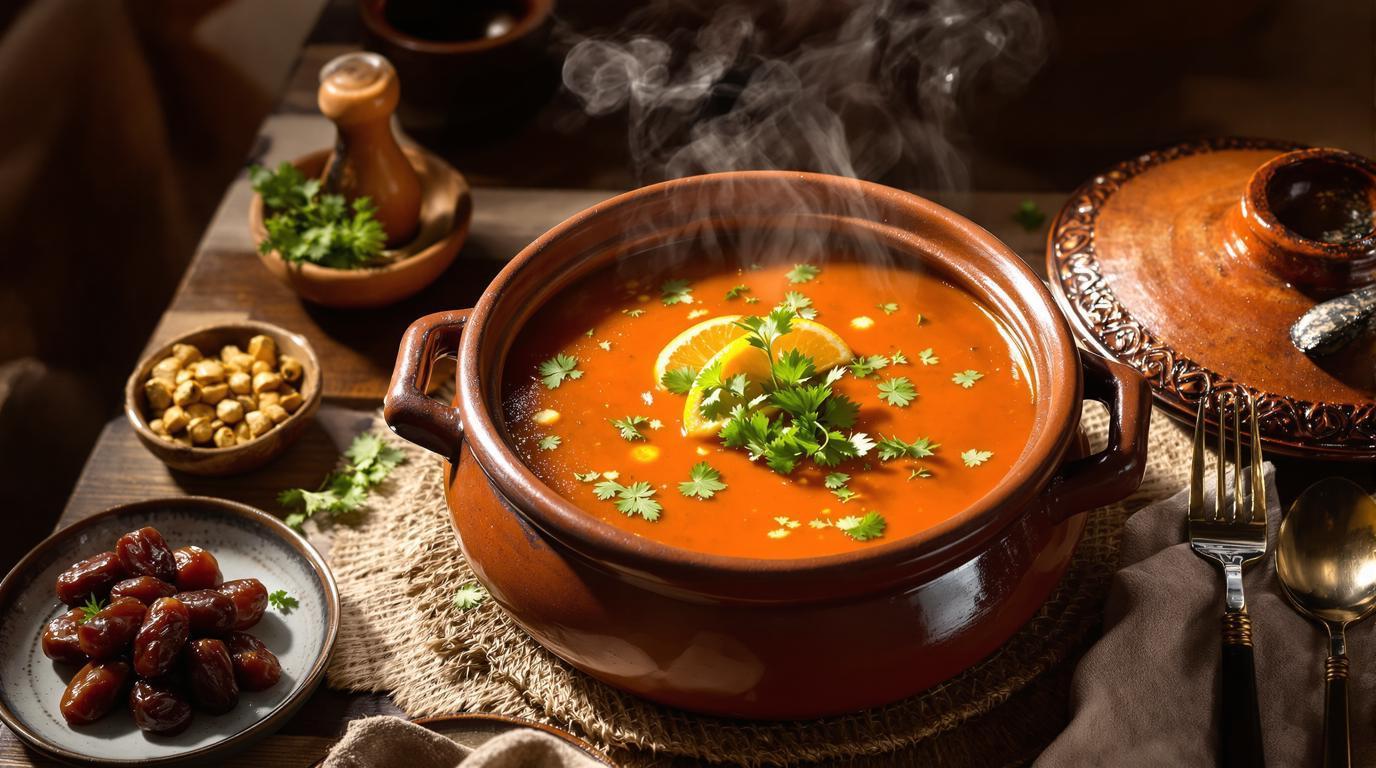The first time I encountered traditional Moroccan harira, I was staging at a restaurant in Marrakech. What struck me wasn’t just the symphony of spices or the velvety texture—it was the reverence with which it was prepared. The head chef, whose grandmother’s recipe we followed, insisted on peeling each chickpea by hand after soaking. “This is the difference between harira and exceptional harira,” he said. That patience transformed a humble soup into something transcendent—a perfect balance of hearty and refined that I’ve been perfecting ever since.
The Story
Harira isn’t just any soup—it’s the cornerstone of Ramadan tables across Morocco, though it deserves a place in every cook’s repertoire year-round. This tomato-based wonder marries legumes, tender meat, and a complex spice profile into something greater than the sum of its parts. What makes authentic harira special is the layering of flavors and the careful thickening technique called tedouira—a flour slurry that creates that signature silky mouthfeel without heaviness.
Ingredients Spotlight
The soul of harira comes from building layers of flavor:
- 200g (7oz) dried chickpeas, soaked overnight and peeled
- 100g (3.5oz) brown or green lentils
- 800g (1.7lbs) fresh tomatoes, peeled and diced (canned work in a pinch)
- 450g (1lb) lamb shoulder or beef chuck, cubed (optional for vegetarian version)
- 1 large onion, finely grated
- 2 celery stalks, finely diced
- ¼ cup each fresh cilantro and parsley, chopped
- Spice blend: 1 tsp turmeric, 1 tbsp ginger, ½ tsp cinnamon, ¼ tsp black pepper, pinch of saffron threads
- 3 tbsp tomato paste
- 50g (½ cup) all-purpose flour mixed with 120ml (½ cup) water for tedouira
- 25g (¼ cup) broken vermicelli or angel hair pasta (optional)
- 1 tsp smen (Moroccan preserved butter) or regular butter plus a splash of vinegar
Step-by-Step Guide
1. Prepare the base: In a large, heavy pot, heat 2 tablespoons olive oil over medium heat. Add your spices and toast for 30 seconds until fragrant—this blooms their essential oils and transforms the flavor profile.
2. Build the foundation: Add the grated onion and celery, sautéing until translucent but not browned, about 4 minutes. Stir in tomato paste and cook for another minute.
3. Create the body: Add the diced tomatoes, soaked chickpeas, lentils, and meat (if using). Pour in 2 liters (8 cups) of water, bring to a boil, then reduce to a gentle simmer. Season with salt.
4. The long simmer: Partially cover and simmer for 60-90 minutes until the chickpeas are tender and meat is falling apart. For pressure cooker enthusiasts, this reduces to about 35 minutes at high pressure with natural release.
5. The critical finish: When legumes are tender, prepare the tedouira by whisking flour and water until completely smooth. Gradually stream into the simmering soup while stirring constantly to prevent lumps. Simmer for 10 minutes as it thickens.
6. Final touches: If using vermicelli, add now and cook for 5-7 minutes until tender. Stir in chopped herbs and smen. Taste and adjust seasonings.
Expert Techniques
The difference between good harira and exceptional harira lies in three techniques:
Chef’s Note: The tedouira technique is what gives harira its distinctive velvety texture. Be patient with this step—gradually add the slurry while stirring constantly, then maintain a gentle simmer so the flour can cook properly without scorching. This prevents the raw flour taste that mars many homemade versions.
Second, peeling chickpeas might seem tedious, but it’s transformative. After soaking overnight, the skins slip off easily between your fingers. This extra 10 minutes of work eliminates any bitterness and creates incomparable smoothness.
Finally, resist the urge to rush. Authentic harira develops its complex character through slow simmering, allowing the spices to meld and the proteins to break down into that rich, satisfying texture.
Presentation & Pairing Ideas
Serve harira steaming hot in wide bowls, garnished with fresh cilantro leaves and accompanied by lemon wedges for guests to adjust brightness to taste. In Morocco, this would be paired with dates and honey-drizzled flatbreads.
For a complete meal, I recommend serving alongside a simple arugula salad with preserved lemon dressing. The peppery greens and citrus notes cut through the richness beautifully. If you’re looking for wine pairings, an unoaked Chardonnay or Viognier complements the spices without overwhelming them.
Harira freezes exceptionally well, though I recommend adding fresh herbs after reheating. Make a double batch and you’ll have the foundation for quick weeknight meals that taste like they took hours—because originally, they did. The complex flavors actually improve after a day or two, making this the perfect make-ahead dish for entertaining or busy weeks, similar to how cassoulet or braised short ribs develop over time.
This soup exemplifies how humble ingredients transform through technique and patience. Make it your own—perhaps adding fire-roasted peppers like in Basque stews, or experimenting with different legume combinations. The true spirit of harira isn’t rigid authenticity but the soul-warming comfort it brings to your table. 🍲✨
